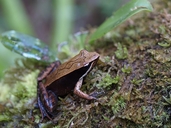|
Description
M 30-40 mm, F 32-41 mm. Tibiotarsal articulation reaches beyond snout tip. Fifth toe longer than third toe. Femoral glands in males small and indistinct. Frenal stripe very distinct and reaching the nostril. Ventrally often with a dark throat with a thin light median line. Dorsally often with a diamond-shaped marking (Glaw and Vences 2007). Distribution and Habitat
Country distribution from AmphibiaWeb's database: Madagascar
Widely distributed in eastern Madagascar (Vences and Glaw 2008). Ambatovaky, An’Ala, Andasibe, Andohahela, Andranomena, Anjozorobe, Bekazaha, Chaines Anosyennes, Ifanadiana, Ilampy, Isaka-Ivondro, Manantantely, Mantadia, Marojejy, Marovitsika, Midongy, Moramanga, Nahampoana, Ranomafana (Imaloka, Maharira forest, Ranomena, Vohiparara), near Ifanadiana, Sahembendrana, Tsararano, Vohidrazana, Zahamena (Glaw and Vences 2007). Found in rainforest and at forest edges at 200-900 m asl (Vences and Glaw 2008).Life History, Abundance, Activity, and Special Behaviors
Habits: Juvenile and adult specimens are commonly encountered on the forest floor near streams. Males call during the day from the ground or from elevated positions up to 50 cm above the ground, such as tree holes (Glaw and Vences 2007). Breeds in brooks (Vences and Glaw 2008).
Calls: Rapid series of 12-48 short pulsed notes. Notes are shorter and call series faster than in M. opiparis (Glaw and Vences 2007).
Trends and Threats
Abundant but decreasing. The main threat is habitat loss due to subsistence agriculture, logging, charcoal manufacture, invasion and spread of eucalyptus, grazing, and expanding human settlement. It does not tolerate heavy forest degradation. However, this species occurs within many protected areas (Vences and Glaw 2008). Possible reasons for amphibian decline General habitat alteration and loss
Habitat modification from deforestation, or logging related activities
Intensified agriculture or grazing
Urbanization
Subtle changes to necessary specialized habitat
Comments
Taken with permission from Glaw and Vences (2007) and Vences and Glaw (2008).
References
Glaw, F., and Vences, M. (2007). Field Guide to the Amphibians and Reptiles of Madagascar. Third Edition. Vences and Glaw Verlag, Köln.
Vences, M. and Glaw, F. (2008). Mantidactylus melanopleura. In: IUCN 2008. 2008 IUCN Red List of Threatened Species. www.iucnredlist.org. Downloaded on 07 April 2009.
Originally submitted by: Miguel Vences and Frank Glaw (first posted 2009-04-07)
Edited by: Kellie Whittaker (2009-04-08)Species Account Citation: AmphibiaWeb 2009 Mantidactylus melanopleura <https://amphibiaweb.org/species/6239> University of California, Berkeley, CA, USA. Accessed Nov 12, 2024.
Feedback or comments about this page.
Citation: AmphibiaWeb. 2024. <https://amphibiaweb.org> University of California, Berkeley, CA, USA. Accessed 12 Nov 2024.
AmphibiaWeb's policy on data use.
|
